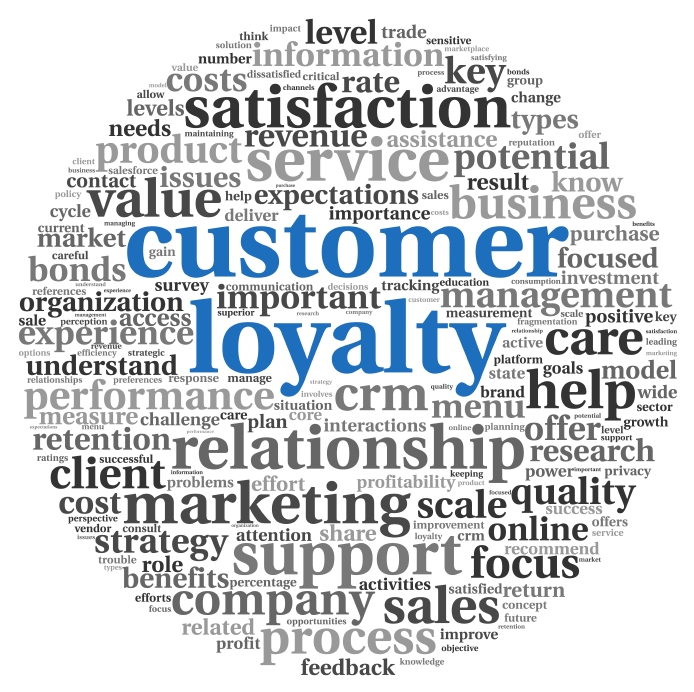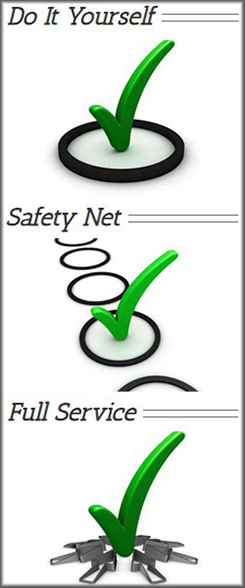Expand Your Customer Satisfaction Research Focus
 Customer satisfaction: How Big are you Thinking? Some companies take customer satisfaction at face value. They buy in logically at a fundamental level ‘“ “We should measure customer satisfaction.” So, they track some overall measure of satisfaction, and perhaps some detailed “components” of satisfaction (e.g., satisfaction with products, with sales reps, etc.). They might even compensate employees for satisfaction scores. While it is a worthy goal in a customer-driven economy, these track-it-only companies are really viewing satisfaction as an end in and of itself. Other companies think a little bigger. They also track satisfaction, but not just as an end in itself. They see satisfaction strategically ‘“ a means to a higher end. They embrace conventional marketing wisdom that says customer satisfaction positively links to retention, increased spending, positive word-of-mouth, increased share of purchase, and profit. So these companies purposefully seek to influence satisfaction by improving the various component factors. Their logic is intuitive and clear: drive components, to drive overall satisfaction, to realize desired business outcomes. Special statistical approaches are often used to model cause-effect hierarchies from components to the overall measure. Statistical coefficients of “importance” are combined with measures of performance to identify essential improvement priorities (i.e., areas with high importance, low performance). But some organizations think even more strategically. They think about more than just “satisfaction” measurement and management. These companies recognize that other critical constructs come naturally with the satisfaction territory. After all, satisfaction can’t fully explain customer retention. So, other constructs are measured. Things like relative value, relative quality, relative price, switching costs, and even perceptions of image and reputation, all are simultaneously measured and managed as key constructs in achieving organizational goals. Satisfaction is one important idea but only one among many. However, there is still room to think bigger. Even if a company focuses on the expanded set of “satisfaction” constructs, they are typically missing something by dealing only with current customers. That is hardly a representative picture of perceptions and behaviors in the full market! What management really needs is more comprehensive “customer” information ‘“ information about prospective customers, the acquisition process relative to competitive offerings, changes in customer wants/needs across time, problem experiences, customer defection data, and potential reacquisition information. Companies that put satisfaction in this kind of broader “life cycle” context, acquisition-retention-defection, are much more equipped to manage their customer base strategically. This bigger-picture view is especially valuable for industries with high levels of churn (e.g., cellular phone service). But other companies go even further still. They view the customer life cycle perspective simply as a subsystem in a much larger organizational management framework. Webs of other interconnected forces and stakeholders (e.g., employees, investors, etc.) shape the ultimate success of the company. Customer life cycle factors obviously are essential, but only one of many considerations in a broader, organization-wide system. As a simple example, consider the power in recognizing that employee experiences directly affect customer experiences. That fact calls for employees and customers to be viewed as a system, and to be strategically managed simultaneously rather than as isolated individual elements. Many other interconnected effects also must be viewed as essential in a truly comprehensive simultaneous system of organizational measurement and management. Consider some of the following examples of causal connections:
Customer satisfaction: How Big are you Thinking? Some companies take customer satisfaction at face value. They buy in logically at a fundamental level ‘“ “We should measure customer satisfaction.” So, they track some overall measure of satisfaction, and perhaps some detailed “components” of satisfaction (e.g., satisfaction with products, with sales reps, etc.). They might even compensate employees for satisfaction scores. While it is a worthy goal in a customer-driven economy, these track-it-only companies are really viewing satisfaction as an end in and of itself. Other companies think a little bigger. They also track satisfaction, but not just as an end in itself. They see satisfaction strategically ‘“ a means to a higher end. They embrace conventional marketing wisdom that says customer satisfaction positively links to retention, increased spending, positive word-of-mouth, increased share of purchase, and profit. So these companies purposefully seek to influence satisfaction by improving the various component factors. Their logic is intuitive and clear: drive components, to drive overall satisfaction, to realize desired business outcomes. Special statistical approaches are often used to model cause-effect hierarchies from components to the overall measure. Statistical coefficients of “importance” are combined with measures of performance to identify essential improvement priorities (i.e., areas with high importance, low performance). But some organizations think even more strategically. They think about more than just “satisfaction” measurement and management. These companies recognize that other critical constructs come naturally with the satisfaction territory. After all, satisfaction can’t fully explain customer retention. So, other constructs are measured. Things like relative value, relative quality, relative price, switching costs, and even perceptions of image and reputation, all are simultaneously measured and managed as key constructs in achieving organizational goals. Satisfaction is one important idea but only one among many. However, there is still room to think bigger. Even if a company focuses on the expanded set of “satisfaction” constructs, they are typically missing something by dealing only with current customers. That is hardly a representative picture of perceptions and behaviors in the full market! What management really needs is more comprehensive “customer” information ‘“ information about prospective customers, the acquisition process relative to competitive offerings, changes in customer wants/needs across time, problem experiences, customer defection data, and potential reacquisition information. Companies that put satisfaction in this kind of broader “life cycle” context, acquisition-retention-defection, are much more equipped to manage their customer base strategically. This bigger-picture view is especially valuable for industries with high levels of churn (e.g., cellular phone service). But other companies go even further still. They view the customer life cycle perspective simply as a subsystem in a much larger organizational management framework. Webs of other interconnected forces and stakeholders (e.g., employees, investors, etc.) shape the ultimate success of the company. Customer life cycle factors obviously are essential, but only one of many considerations in a broader, organization-wide system. As a simple example, consider the power in recognizing that employee experiences directly affect customer experiences. That fact calls for employees and customers to be viewed as a system, and to be strategically managed simultaneously rather than as isolated individual elements. Many other interconnected effects also must be viewed as essential in a truly comprehensive simultaneous system of organizational measurement and management. Consider some of the following examples of causal connections:
- Corporate reputation – Prospect, customer, and employee perceptions
- Managerial ethics – Customer and employee experiences
- Operational practices – Employee experiences
- Employee experiences – Customer experiences
- Customer and employee behaviors – Financial outcomes
- Financial outcomes – Investor perceptions and behaviors
So when it comes to customer satisfaction, my bottom line question is simple: how big are you thinking? Whether you are more like the first kind of company described here, or more like the last, or like something in between, the important point is to start viewing customer satisfaction differently. Customer satisfaction is critical, yes ‘“ but it is simply one part of a much larger organizational environment. We should move away from the isolated component view and start thinking big — about systems and interconnected integrated wholes. Systems-level thinking in ecology considers individual species not in isolation, but in the context of interdependent ecosystems. Organizationally, customer satisfaction is similar in that it too should not be viewed or managed in isolation. It is an essential element of organizational health, but it exists in a much broader system of measurement and management factors that lead to organizational success.
Learn more about how to broaden your organization’s perspective on customer satisfaction research – download Dr. Grisaffe’s journal article on this subject now.
By: Doug Grisaffe, Ph.D., Professor of Marketing, University of Texas, Arlington




